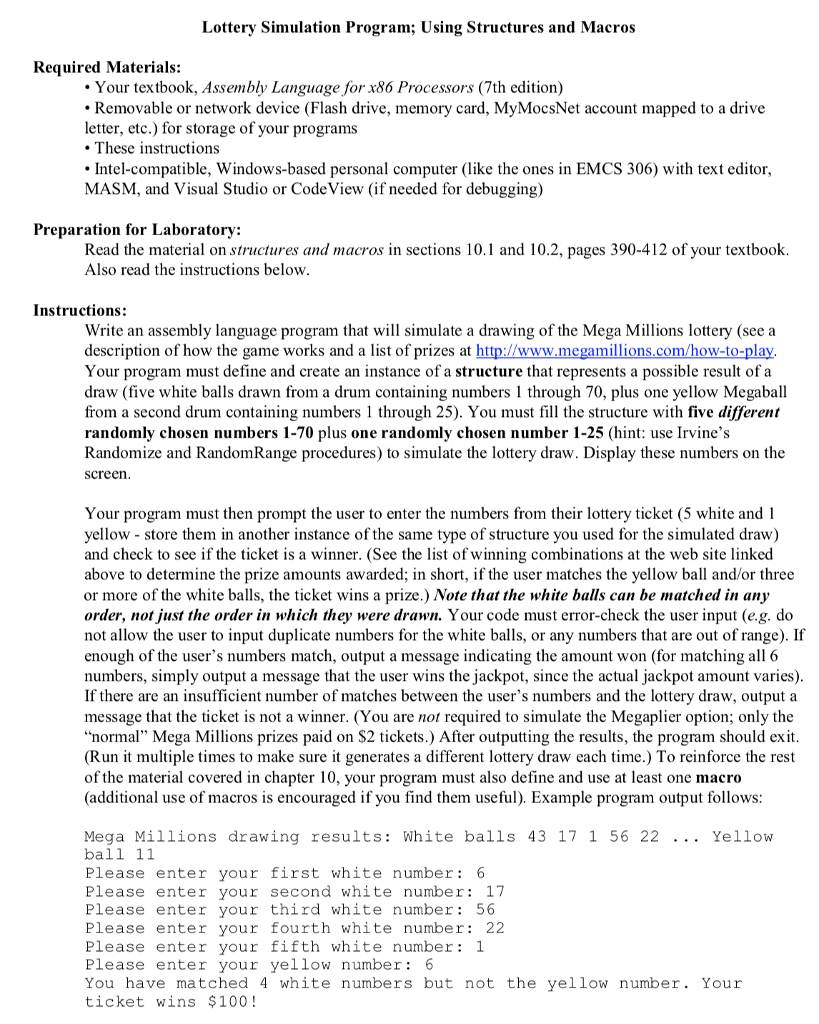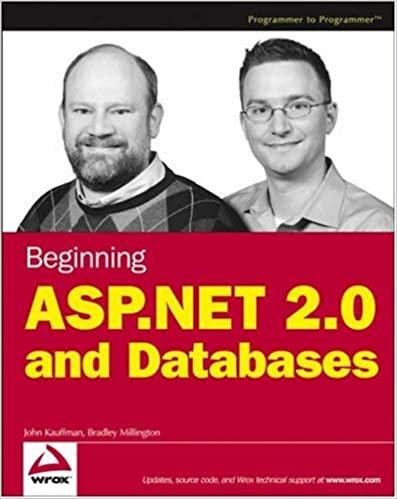Answered step by step
Verified Expert Solution
Question
1 Approved Answer
Please help me my teacher doesnt teach Lottery Simulation Program; Using Structures and Macros Required Materials .Your textbook, Assembly Language for x86 Processors (7th edition)

Please help me my teacher doesnt teach
Lottery Simulation Program; Using Structures and Macros Required Materials .Your textbook, Assembly Language for x86 Processors (7th edition) Removable or network device (Flash drive, memory card, MyMocsNet account mapped to a drive letter, etc.) for storage of your programs These instructions Intel-compatible, Windows-based personal computer (like the ones in EMCS 306) with text editor, MASM, and Visual Studio or CodeView (if needed for debugging) Preparation for Laboratory: Read the material on structures and macros in sections 10.1 and 10.2, pages 390-412 of your textbook Also read the instructions below Instructions: Write an assembly language program that will simulate a drawing of the Mega Millions lottery (see a description of how the game works and a list of prizes at http://www.megamillions.com/how-to-play Your program must define and create an instance of a structure that represents a possible result of a draw (five white balls drawn from a drum containing numbers 1 through 70, plus one yellow Megaball from a second drum containing numbers 1 through 25). You must fill the structure with five different randomly chosen numbers 1-70 plus one randomly chosen number 1-25 (hint: use Irvine's Randomize and RandomRange procedures) to simulate the lottery draw. Display these numbers on the screen Your program must then prompt the user to enter the numbers from their lottery ticket (5 white and 1 yellow - store them in another instance of the same type of structure you used for the simulated draw) and check to see if the ticket is a winner. (See the list of winning combinations at the web site linked above to determine the prize amounts awarded; in short, if the user matches the yellow ball and/or three or more of the white balls, the ticket wins a prize.) Note that the white balls can be matched in any order, not just the order in which they were drawn. Your code must error-check the user input (e.g. do not allow the user to input duplicate numbers for the white balls, or any numbers that are out of range). If enough of the user's numbers match, output a message indicating the amount won (for matching all 6 numbers, simply output a message that the user wins the jackpot, since the actual jackpot amount varies) If there are an insufficient number of matches between the user's numbers and the lottery draw, output a message that the ticket is not a winner. (You are not required to simulate the Megaplier option; only the "normal" Mega Millions prizes paid on $2 tickets.) After outputting the results, the program should exit (Run it multiple times to make sure it generates a different lottery draw each time.) To reinforce the rest of the material covered in chapter 10, your program must also define and use at least one macro (additional use of macros is encouraged if you find them useful). Example program output follows: Mega Millions drawing results: White balls 43 17 1 56 22 Yellow ball 11 Please enter your first white number 6 Please enter your second white number 17 Please enter your third white number 56 Please enter your fourth white number 22 Please enter your fifth white number 1 Please enter your yellow number 6 You have matched 4 white numbers but not the yellow number. Your ticket wins $100! Lottery Simulation Program; Using Structures and Macros Required Materials .Your textbook, Assembly Language for x86 Processors (7th edition) Removable or network device (Flash drive, memory card, MyMocsNet account mapped to a drive letter, etc.) for storage of your programs These instructions Intel-compatible, Windows-based personal computer (like the ones in EMCS 306) with text editor, MASM, and Visual Studio or CodeView (if needed for debugging) Preparation for Laboratory: Read the material on structures and macros in sections 10.1 and 10.2, pages 390-412 of your textbook Also read the instructions below Instructions: Write an assembly language program that will simulate a drawing of the Mega Millions lottery (see a description of how the game works and a list of prizes at http://www.megamillions.com/how-to-play Your program must define and create an instance of a structure that represents a possible result of a draw (five white balls drawn from a drum containing numbers 1 through 70, plus one yellow Megaball from a second drum containing numbers 1 through 25). You must fill the structure with five different randomly chosen numbers 1-70 plus one randomly chosen number 1-25 (hint: use Irvine's Randomize and RandomRange procedures) to simulate the lottery draw. Display these numbers on the screen Your program must then prompt the user to enter the numbers from their lottery ticket (5 white and 1 yellow - store them in another instance of the same type of structure you used for the simulated draw) and check to see if the ticket is a winner. (See the list of winning combinations at the web site linked above to determine the prize amounts awarded; in short, if the user matches the yellow ball and/or three or more of the white balls, the ticket wins a prize.) Note that the white balls can be matched in any order, not just the order in which they were drawn. Your code must error-check the user input (e.g. do not allow the user to input duplicate numbers for the white balls, or any numbers that are out of range). If enough of the user's numbers match, output a message indicating the amount won (for matching all 6 numbers, simply output a message that the user wins the jackpot, since the actual jackpot amount varies) If there are an insufficient number of matches between the user's numbers and the lottery draw, output a message that the ticket is not a winner. (You are not required to simulate the Megaplier option; only the "normal" Mega Millions prizes paid on $2 tickets.) After outputting the results, the program should exit (Run it multiple times to make sure it generates a different lottery draw each time.) To reinforce the rest of the material covered in chapter 10, your program must also define and use at least one macro (additional use of macros is encouraged if you find them useful). Example program output follows: Mega Millions drawing results: White balls 43 17 1 56 22 Yellow ball 11 Please enter your first white number 6 Please enter your second white number 17 Please enter your third white number 56 Please enter your fourth white number 22 Please enter your fifth white number 1 Please enter your yellow number 6 You have matched 4 white numbers but not the yellow number. Your ticket wins $100
Step by Step Solution
There are 3 Steps involved in it
Step: 1

Get Instant Access to Expert-Tailored Solutions
See step-by-step solutions with expert insights and AI powered tools for academic success
Step: 2

Step: 3

Ace Your Homework with AI
Get the answers you need in no time with our AI-driven, step-by-step assistance
Get Started


